|
FAQs on Aquatic Insects and Freshwater
Aquariums:
Control
Related Articles:
Invertebrates in Freshwater Aquariums,
Invertebrates for Freshwater
Aquariums by Neale Monks,
FAQs on Aquatic Insects:
Aquatic
Insects 1,
Aquatic Insects 2,
Aquatic Insects 3,
Aquatic Insects 4,
Aquatic Insect Identification,
FAQs on Aquatic Insects by Group:
Beetles, Dragonflies,
Flies in General (Caddis, Gnats, Midges...),
Freshwater Mites,
Mosquitos/Mozzies and much more!
|
|
|
Freshwater Bugs Identification and course of action needed
7/26/19
Good Afternoon. I have a 100 gal freshwater tank with male peacocks, giant
danios, and Synodontis petricola. Tank is established with canister and sponge
filtration, lightly planted, and no new fish have been added to the tank
recently. Parameters are good, a little high on nitrates but adding extra water
changes. I found a number of extremely small critters just above the water line
that appear to be feeding on a flake of food that stuck to the side of the
glass. They move around a good bit, appear to fight with each other, but I just
would like to know what they are and make sure they are no threat to my tank.
The photo enclosed is very magnified.
Thanks, Cindy.
<Hello Cindy. These are probably members of the Collembola, colloquially known
as Springtails. They're completely harmless, and as you observe, feed on organic
detritus in damp areas. Most aquaria have them, but sometimes they do 'bloom' if
there's a lot of food for them. If you regularly wipe down the glass above the
waterline, and avoid overfeeding, you can control their numbers, But in all
honesty, I'd ignore them! Cheers, Neale.>
|
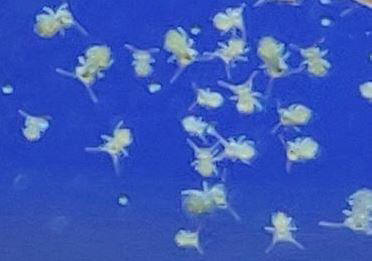 |
|
Worm, Larvae, or other?
3/14/16
Hi There,
<Matt>
Just finished cycling a Fluval Edge 6 gallon aquarium after 4 weeks. I
cycled with pure ammonia from Dr. Tim's Aquatics dosing 4ppm each day the
ammonia read 0ppm. The tank is planted with Helianthus callitrichoides,
Lilaeopsis brasiliensis, Vesicularia dubyana, and a few Aegagropila
linnaei. I dose with Flourish Comprehensive weekly and Fluorish Excel
daily with 12h/day lightning by means of my Finnex Planted+. The plants
are all
growing wonderfully. There are also some snails that hitched a ride on
the Java Moss
<http://www.fishlore.com/fishforum/aquarium-plant-profiles/114960-java-moss-care-sheet.html>
I purchased from my LFS
<http://www.fishlore.com/fishdictionary/l.htm#lfs>
, which I don't mind at the moment.
<Okay>
I have yet to perform a water change
<http://www.fishlore.com/fishdictionary/w.htm#waterchange>
and will do so after I figure out what these pests are. First here are
the water specs to get an idea of the conditions:
pH 7.0
DKH <http://www.fishlore.com/fishdictionary/d.htm#dkh>
4
dGH 4
NH3, NO2 0ppm
NO3 80ppm (as I said, have yet to do a water change
<http://www.fishlore.com/fishdictionary/w.htm#waterchange>
!)
<You're disciplined!>
They
<Who? The worms I'll assume.>
have definitely proliferated in the past few days (probably due to
increased nitrate concentration), with most coming out at night and
wiggling erratically at the top of the tank. Few also float in the water
column during the day. The majority are translucent with some varying
with brown specks. The supposed worms appear to be segmented, which
leads me to believe they are of the Annelid phylum or are larvae of some
kind
<Likely so>
and therefore not Planaria, but then again I could just be seeing
things.
Maybe they are some sort of Dipteran larvae?
<Can you send along a well-resolved pic? The two groups of
invertebrates can be discerned on close inspection>
Please let me know!
Thanks,
Matthew
<Please read here re identifying these groups:
http://wetwebmedia.com/FWSubWebIndex/fwwormidf.htm
and
http://wetwebmedia.com/FWAqInsectF2.htm
Bob Fenner>
Re: Worm, Larvae, or other?
3/14/16
Oh yes! The most important part of the email was omitted! Here is a
photo:
<Ahh; these appear to be insect larvae. I'd vacuum the gravel to remove
them. Bob Fenner>
|
 |
|
Re: Worm, Larvae, or other?
3/14/16
Thanks for the help IDing them! I am planning on getting a school of 6
cardinal tetras, so I hope they will find them to be a delicious treat.
<Which? I'd remove the larvae as stated... They may turn out to be fish
eaters, or flying about your house... BobF>
|
Nematode worms 6/19/15
Dear WWM crew,
I happened upon your site following several searches to try and identify the
worm-like creatures I found on the bottom of my outdoor swimming pool.
I realize your site is for aquarium enthusiasts, but your specialists seem
really knowledgeable about worms and larvae, unlike most of the drivel I find in
"Yahoo Answer-like" web postings. Could you help identify the fast wriggling
creatures in the attached video, <insect
pool larv.mov> and recommend how I can get rid of them? They inhabit a 100ft
long outdoor swimming pool for recreational swimming and most users would
probably not like to share their swimming enjoyment with these creatures.
Thank you for your expertise!
Best regards,
Marc de Beer
<There isn't enough detail to say what sort of "worms" these are, whether
annelids, nematodes, Nematomorpha or insect larvae. Nematomorphs are pretty
common though, and generally harmless to us since they infect different sorts of
animals. Unfortunately, chlorine levels in pools are not normally high enough to
kill the durable eggs of some "worms", and insect larvae may appear repeatedly
because the flies, mosquitoes and other species can come to a clean pool and lay
their eggs there. In short, there isn't a one-shot chemical solution to these.
Net them out, and in particular, remove potential hosts as quickly as you can to
prevent possible reinfection -- typical hosts for Nematomorpha are insects
including flies, crickets,
beetles and so on. Cheers, Neale.>
<From the motion of the animal in your MOV, am pretty sure this/these are insect
larva/e... See WWM re. Bob Fenner>
Re: Nematode worms 6/20/15
Thank you so much!
<Welcome>
Best regards,
Marc
<Simple chlorine shocking procedure will very likely rid your system of these
larval insects. BobF>
|
Help in identifying plant eating larvae 6/18/2013
Hi,
This morning i found a larvae eating my plants. Can you help my identify it
<Mmm, an intermediate form/metamorphosis of some aquatic insect>
my water plant shop reseller haven't seen this in the past.
Its about 1 inch long, and transparent.(not green like in picture) when i
removed it from water, it shrank and lost its internal water.
I don't have any fish in the tank yet. I started it only 10 days ago.
I assume it was a hitchhiker on one of the plants and therefore i can expect
more.
<Likely so>
If so, i want to know if its dangerous to fish as well as eating my
plants....
<Best to poison, remove... Please read here:
http://www.wetwebmedia.com/fwsubwebindex/fwaqinsectfaqs.htm
i was planning to add fish in two weeks but would like to do a water
treatment in advance if necessary.
<Yes, I would. An acetylcholinesterase inhibitor... As you'll read... an
insecticide. Bob Fenner; fresh out of time>
thanks
David
|
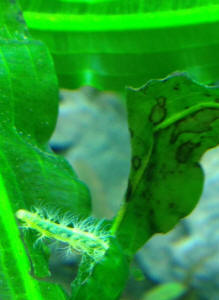
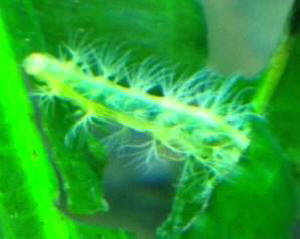
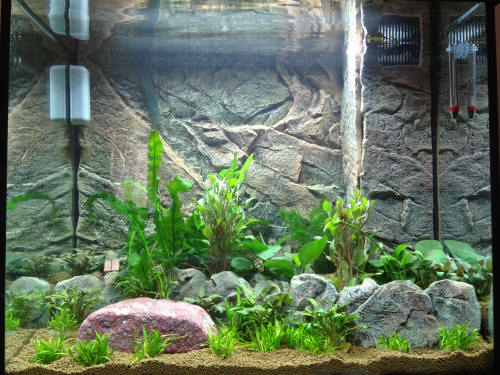 |
|
Re: Help in identifying plant eating larvae
6/19/2013
Thanks for your quick reply.
acetylcholinesterase inhibitors which are insecticides can be dangerous
to my plants ? or biological filter ? Its an organic phosphor molecule ?
how should i use it ?
<... please learn to/use the search tool, indices on WWM:
Read here:
http://www.wetwebmedia.com/FWSubWebIndex/organophosphatefaqs.htm
and related (arthropods) here:
http://www.wetwebmedia.com/FWSubWebIndex/fwcrustdisfaqs.htm
Which companies sell them for aquarium purposes ? Tetra ? Sera ? Seachem
?
What is the safe dosage for a 120 Liter aquarium.
should i wait a few weeks before taking this drastic measure and see if
i have more of these pests ?
<I wouldn't>
i am not in a hurry . though my two daughters are impatient to see
fishes swimming in the tank :)
sorry for throwing all those questions on you.
Regards,
David
<No worries. Just short of time today. BobF>
|
Planted Tank, fish sel. for pest control
11/9/11
Dear WWM,
Usually this would concern marine topics, however I do have a 20 gallon
freshwater planted. My goal when I purchased it was to make a tank that
would be almost self sufficient, obviously it needs water added on
occasion due to evaporation and flow provided, my end product has a
small heater, and filter, and standard light (also receives ample
sunlight). Stocked with Micro Sword which is growing across that tank;
Amazon Sword that has more than doubled in size and number of leaves;
Argentine Swords which grow and are a nice back drop, Java Fern slow
growing, and what I believe to be a Ludwigia peruensis that likes to
loose leaves every time new ones grow in.
I also have two Apple Snails, Six Ghost shrimp that keep having babies
whom I can never find. I would assume this is due to the free swimming
larva encountering the filter. One common Pleco. I also have gnats that
like to land and die in the water much to my dismay. Is there a
fish I could get that would not have a high demand or be over-whelming
to my tank that would eat the gnats and algae? The algae I
already identified to be Green Spot Algae rather than a
non-photosynthetic type. Thanks.
Bryce
<Depending on water temperature and water chemistry, something from
the killifish or livebearer groups would seem most appropriate here. At
low-end tropical temperatures, Florida Flagfish can make excellent
algae eaters.
They're territorial but not especially aggressive. Other
pupfish-type Killies might be used depending on their availability in
your area.
Livebearers are good for tanks with moderately hard to hard water.
Alfaro cultratus is an exception, doing well in soft water, though it
is difficult to breed and eats mostly insects rather than algae. On the
other hand, Limia nigrofasciata is an excellent algae-eater and unusual
enough that passing on excess fry is easy to do. The Dwarf
Mosquitofish, Heterandria formosa, would be an excellent choice for
your tank, being so small it'd have minimal impact on water quality
unless you kept hundreds. Naturally, you could go with plain vanilla
livebearers too, such as Endler's. Just as an aside, the Plec has
no place in this tank and will cause trouble before long; neither will
it do much/anything to hold back algae. Replace with an Ancistrus
instead; these are smaller, reasonably good algae eaters, and very easy
to keep. Otocinclus might be an option too, but they're delicate,
dislike warm water, easily starved, and often die within a few months
or a year of purchase. Cherry Shrimps are much easier to breed, and
they're also more colourful, and in my opinion the best all-around
shrimps for most tanks. Do bear in mind that Green Spot Algae isn't
going to be removed by any fish. To deal with this algae type, you want
to adopt a preventative approach, perhaps through a combination of
physical removal of what you have now, Nerite snails for scraping away
new colonies before they start, and the use of fast-growing plants
(ideally, floating plants) to inhibit algal growth. Cheers,
Neale.>
|
Yellow Bugs in Tank --
8/20/09
<Hello Tiffany, Lynn here this morning.>
We have a 40 gal tank that's well established, 4+ years.
<Freshwater, saltwater, or brackish?>
About two weeks ago I noticed some tiny yellow bugs on the glass
walls hanging out above the water line. If I go to touch or
remove them they hop or jump out of the way, either to another
spot on the wall or on top of the water. I can't see any in
the water.
<Okay>
I tried to take a pic but you can't see them in the picture.
Approx. size of salt grains. Population has gotten larger this
week. What are they?
<Most likely nothing bad, but I need more information. I need
to know the water type and anything else you can tell me to
describe the 'bugs'. If you have a magnifying glass, get
that out and take a good look at one. Tell me what you see. I can
appreciate how difficult it would be to get a photo of these
little guys, but if you're able to, please send it
along!>
How do I get rid of them or prevent in future?
<Again, they may be completely harmless, but I imagine you
could wipe out quite a few by taking a quick swipe across the
glass with a clean, plain white (one with no dyes/designs on it),
paper towel. For those on top of the water, get another piece (or
length) of paper toweling (just a bit longer than the tank is
wide), grasp both ends and drag across the surface. That should
pick up quite a few as well. Repeat as necessary.>
I just spent an hour or so reading through posts and can't
find anything on yellow bugs like this. Hope you can help...
Tiffany J.
<Take care, LynnZ>
Help with ID query, please? 8/22/09
Hello Bob and fellow crew members,
<Hey Lynn!>
I need a hand, please. I answered a query the other day titled
"Yellow Bugs in Tank - 8/20/09". The querior had great
numbers of tiny yellow bugs hopping all over the glass above the
waterline. In the reply, I requested more information, including
water type, and received a follow-up today.
Ends up, it's a FW system and I have no idea what the little
bugs might be.
Has anyone run across these before? I placed the query in the FW
folder.
Thank you so much for your help! Take care,
-LynnZ
<Will respond. BobF>
Re: Help with ID query, please?
Thank you so much, Bob!
-Lynn
<Thank you Lynn. B>
Re: yellow bugs in tank
Sorry its freshwater, only has 4 fish in the tank, I've been
wiping every other day with plain paper towel to no avail.
The sentence in the original email should state, I cannot see any
swimming in the fish tank, only some occasionally on the surface
of the water when I try to get rid of them.
I can't get a close up picture of them b/c the camera keeps
trying to focus and zooms out to do so. They appear to have 6
legs and 2 antenna's each.
<Ahh, a good description... These are almost doubtless insects
of some sort. The adults have "flown in" to reproduce
in your aquarium>
And their body shape reminds me of the bugs you build in the game
called cooties!
<Heee!>
IE it has a few segments and the butt section is kinda heart
shaped.
Tiffany J.
<Wiping these off the edge with clean, white, non-scented
paper towels should rid your system of them over a short
while.
Bob Fenner>
|
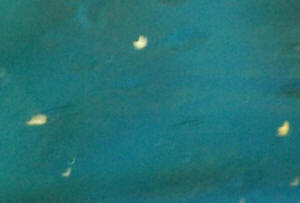 |
|
Re: yellow bugs in tank -- 08/23/09
I've been wiping them off every other day for a couple weeks
now with no success. Is there anything non toxic to fish I can
use like maybe vinegar?
<Not Vinegar, aka Acetic Acid... there are organophosphates
that are sold at times/places as "remedies" that are
toxic to Arthropods mostly, but I would not "stoop" to
their use here>
I even tried to let them dry up about two weeks ago
<Mmm, look to screening the room windows and tank top... new
adults are "sneaking in" and reproducing in your
tank>
when I changed the water and waited over 2 hours to refill the
water after wiping the walls down till they were dry and letting
them sit that way for the 2 hours. thanks for the help or any
ideas!
Tiffany J.
<BobF>
|
Fly Larvae in Turtle Tank, shoo fly,
shoo 6/29/2011
Dear Crew,
<Hiya! Darrel here>
I have a problem with larvae getting into the filters.
<I hate when that happens>
I know there's been questions like this asked but normally they
describe white circles or worms that swim around in the water and are
parasites.
<A parasite swimming around in the water sounds more like my
brother-in-law on vacation in Hawaii>
I know that the larvae grow up to be some type of flying insect, not
sure what kind but they look almost like fruit flies. So here's the
deal:
<OK>
I have a year 1/2 old Red Eared Slider who resides in a 20 gallon
aquarium with a waterfall type filter and a real log.
<Real wood gets really waterlogged and grows real fungus eventually.
An alternative might be some sort of rock or plasticized wood often
sold in aquarium stores for tank decoration>
There have been dark black-brown worm-like larvae crawling on the
filters when I clean the tank every week 1/2 - 2 weeks. I'm not
sure when they start to develop but by the week 1/2 point there is
normally one or two types of flies surrounding the tank;
<Sounds attractive, huh?>
While some may be getting in from outside and being attracted to the
heat lamp, the larvae have been growing on the filters for a couple
months and the filters have been replaced every time I've cleaned
them. Do you know what this could be caused by?
<Yes>
He eats Omega One Adult Turtle Sticks and the filters seem to have a
type of rock in them and are white rectangles.
<Ceramic cells that encourage bio-filtration>
I'm not sure of the brand at this time.
<Many brands '¦ same stuff>
He was found in a pipeline in a steel mill and rescued by my
half-sister's dad who gave him to us.
<Thanks, Dad!! That was really nice of you.>
Thanks for your help, and sorry if this has been asked already!
<No apologies necessary, Courtney. It happens all the time>
<The answer is most likely that you've never fully killed the
eggs, so some hatch and pupate before you even notice and in turn
mature and lay new eggs.>
<So here's what I'd do: Take Piper ('cuz you'd name
a turtle from a pipe Piper, right?) out of the tank and find him a new
place to live for a few days. Someplace warm and DRY. We're going
to keep him out of water except for 15 minutes a day when you put him
in a shallow container of water with a bit of food. He'll eat &
drink and hopefully he'll poop. If he poops in the container water,
which you're flushing - any eggs in his digestive tract will be
eliminated from the cycle. If he poops in his dry box, the eggs will
likely not hatch anyway, but you're still cleaning that up
daily.>
<Meanwhile, leave his tank intact. Water to the regular
"full" level and maybe even an inch more. Add 1 cup of
chlorine bleach per approximate gallon of water. Even a bit more is OK
as long as you can ventilate the room so no one breathes the fumes.
It's important that you leave the filters on and running during
this process. What we want to do is kill the larvae and eggs everywhere
-- inside the tubes, down in the impeller -- all the places you'd
never reach with even the most thorough cleaning. After 24 hours, you
can drain the water, break the system down and clean everything. Rinse,
use soap and water, rinse again & then set it back up.>
<Let it run clean & sterile for another 3 days, then put Piper
back in. Chances are that you'll have broken the larvae
cycle>
<How was THAT as an answer on a scale of 1 to 10???>
Ftn. leeches?? 12/17/10
I have found small red worms that strongly resemble ones discussed on
these two pages
http://www.wetwebmedia.com/fwsubwebindex/tapewmfwf.htm
http://www.viaquaria.com/forum/showthread.php?1679-Callamanus-worms-%28red-worms-from-fish-s-anus%29-Problem-Solution
in a freshwater outdoor water fountain (with no fish). When I go to
change the water every other day or so they float up and are swept out
of the fountain and into the flowerbed. Birds use the fountain to drink
and I imagine that mammals use it at night. I have red wriggler
earthworms and decollet snails in the yard also,
but never find them in the water fountain.
My questions are;
Are they harmful to birds, cats or skunks etc?
<Can't tell with the information presented... All Leeches are
parasitic...
can't/don't live long w/o hosts. Do yours show segmentation,
suckers?>
If they are harmful how do I eliminate them?
<Simple bleach>
Is it possible to 'dose' the water to prevent their return?
<Depends on the source...>
I don't currently have a pet but when I did she did drink out of
the fountain, when I get another will I have to prevent it from doing
this?
<Doubtful>
Thanks, Pam Kelso
<Welcome. Bob Fenner>
Re: leeches?? 12/18/10
Thank you for the reply. In rummaging around the internet after I sent
this to you I think that I have identified the culprits. They are midge
fly larvae, bloodworms.
<Ahh! Quite common to have such insects w/ aquatic larval stages
using water features opportunistically. And not a disease issue>
Because I clean out the fountain every few days I never saw them at
maturity and they were always small and non-segmented. I know that we
have midge flies so I think that solves it. Thank you for getting back
to me so quickly.
Pam Kelso
<Welcome. BobF>
Damselfly nymph 10/10/10
Greetings!
I have a 20g long shrimp only tank with a medium-fine gravel substrate,
planted with Sagittaria, hornwort, java fern (medium density). 2x 18w
bulbs, nothing out of the ordinary. Housing maybe 20 RCS, 15% water
change weekly. pH ~ 7.6, all chemistries 0. I have found myself a
damselfly nymph (am led to believe is this, and not dragonfly, due to
longer, more slender body). Question is, are they detrimental to RCS
population? I have removed one I saw (is roughly 1' long), do not
see others. Is this a 'keep eyes open for more and take out as
needed' deal, or something more drastic? I don't want to break
this tank down for this. Any advice appreciated.
Brandon
<Brandon, Damselfly nymphs are predators, and they will eat very
small animals of all types, including fish fry. Whether they can
actually kill an adult shrimp is questionable, but they might take
juveniles. Of course Damselfly nymphs do need to eat *something*, so
unless you're providing suitable live or wet-frozen food for them
-- they suck the juices out using their jaws -- it's probably best
to move the nymph to a pond nearby. They're neat animals, and the
adults are beautiful and in some cases endangered. One last thing,
Damselfly nymphs are distinct from Dragonfly nymphs in having three
breathing tubes at the tail-end of their abdomen, structures that
Dragonfly nymphs lack. Cheers, Neale.>
Re: Damselfly nymph 10/10/10
Indeed a damselfly nymph then.
<Good.>
I have moved said nymph to another location, but in the absence of
naked-eye visible ones, is it likely there are more?
<Unlikely. This is indoors? Unless you have damselflies flying
around your home, it's most likely this one came via plants or live
food, both of which can be cultivated outdoors or in large glasshouses
where damselflies might be buzzing about.>
I suppose it's just a keep watch, remove as needed affair?
<Yep.>
Probably half my shrimp are berried at various stages, so I don't
believe population-wise the nymphs will pose an issue, unless they
appear in large numbers. Just keep eyes open and remove PRN?
<Pretty much. They're such neat animals, you might even choose
to keep one as a pet. Some remain in their nymph form for months, even
a couple of years, depending on water temperature. I've used
forceps to feed them wet-frozen bloodworms, and various small live
foods such as glassworms will be taken, so they aren't difficult to
maintain. Cheers, Neale.>
Mysterious white worms (in a freshwater tank)
3/10/10
Good morning!
I am a first time WWM email user. And I find your website tons of help!
I have a question. This morning I cleaned my fish tank and I saw tiny
white worm-like creatures on the glass of the fish tank.
<Likely free-living nematodes and planarians. Not in themselves
dangerous, but a sign that this tank gets too much food and not enough
cleaning, since they feed on uneaten fish food (among other things). In
most tanks you might find a few, but not enough to notice. If there are
obviously lots and lots of them, then you have a problem.>
Also while I was using my siphon I stirred the gravel a little bit and
1-2 inch white worms and my angelfish and guppies started to have a
feast, when I looked in my bucket I saw 50 maybe 100 of them and
I'm worried. They swim in kind of a S shape and when they stick to
the glass they move kind of like an inch worm. Kind of creepy.
<Just nature mopping up the mess you're making. Like cockroaches
in a kitchen.>
I also tried a parasite med. But. I don't think that worked ;(
<Why would it? These aren't parasites. More significantly,
trying to kill a bunch of animals in your aquarium means you're
going to end up with lots of decay, and that means poor water quality.
Imagine if you killed off a nest of rats with rat poison, but just left
the bodies to rot. Bad. The correct approach here is to ignore the
worms, and instead control their numbers so the population dies back
over time. How do you do that? By limiting the amount of food they get
to eat. Feed in sensible amounts, don't overstock your tanks, and
remove uneaten food at once.>
Thank you for your time helping me!
<Cheers, Neale.>
| FW Copepod? -- 05/16/07 Hi Bob, <Hello
George!> Just found this beauty in one of my tanks and I was
wondering if you know whether it is a parasitic copepod or not.
Mind you, it was found in a freshwater tank. Thanks a lot for your
help !! All the best, George J. Reclos <It does appear to be an
aquatic Acarinan... not a Copepod, but might be deleterious...
BobF> |
|
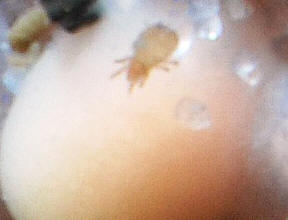
|
| Hi Bob, Thanks for your instant response. Do you
know of any ways to get rid of it ? George <Mmm, yes. In the
absence of other arthropod life, the use of an organophosphate like
DTHP/Masoten/Trichlorfon... or Dimilin. Please read here re:
http://www.wetwebmedia.com/PondSubWebIndex/contrpdparasit.htm
BobF> |
Worms 09/04/2008 Hi I have a 29 gallon
freshwater tank it is a fairly new tank only been up for about 7
weeks.. I just got done battling ick on my swordtail fry and then
today I noticed these brown worm looking things on the glass of the
tank near the top ,but they were not in the water at the time I
found them they were actually just above the surface.. I wiped them
off but not sure if they are a worm or some type of insect larvae..
I have attached 2 photos, not the best because they are very
small.. I tried looking it up myself but all I can find is
references to white worms which these are not white.. Are they
harmful? I already did a 20% water change while vacuuming the
gravel today.. Thanks Trish <Hello Trish. The "worm"
in question appears to be an insect larva. Certainly to my eyes it
seems to be segmented and possesses small appendages of various
types. In other words, a maggot. No immediate threat to the fish,
but a good sign that there's a lot of decaying organic material
somewhere in or around the tank. Otherwise the parent fly (or
whatever) wouldn't have laid its eggs here. So time for an
early spring clean! Cheers, Neale.>
Re: worms
09/04/2008 Thank You.. I did vacuum the gravel out today
after finding the worm like things.. and there was a lot of food in
the gravel.. I didn't realize I was overfeeding , I only feed
them once a day but I guess I
need to cut down on the amount I am
giving each day.. Thanks so much for your speedy response. Trish
<Hi Trish. Overfeeding is easy to do, and much more difficult
than to under-feed! Remember the two golden rules: Firstly, little
but often. Snacking is better than gorging. The fish are more
likely to eat all the food, and they'll also extract more
nutrition with less wastage. Secondly, use the minimum quantity,
and it should all be gone within a minute (for the average greedy
community fish). Remove anything leftover; a turkey baster is a
great tool for this, allowing you to pipette out stuff without
buckets or getting your hands wet. Cheers, Neale.> |
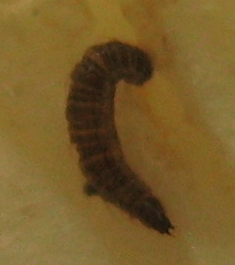
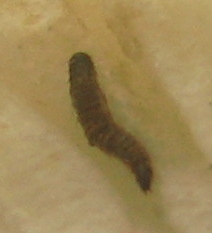 |
Bugs in tank 4/27/07 I have a
50 gallon tank that we fill to about 47 gallons because we have a
fire-bellied toad. Recently, I have seen tons of extremely small darker
colored bugs jumping along the surface and sitting on the tops of our
lily pads. <These aren't bugs (i.e., not Hemiptera) but some
other type of insect, most likely collembolans or some other very
primitive, moisture-loving insect.> The problem is that they seem to
really be bothering our toad because he tries to stay in the water most
of the time now. <Sounds very unlikely. Collembolans eat decaying
plant matter, and pose no threat to a toad. This is a case of two
things happening at the same time, but not actually being related.
Check water quality, humidity, whether they have enough land, scary
things like loud noises, etc.> What can I do to get rid of these
things so he will not be so miserable and what could they be. <You
can't get rid of them any more than ridding your garden of ants.
They're harmless so don't worry too much. If you truly have a
plague of them, then consider what they're eating: if there's
lots of food for them, they'll multiply; if the tank is kept clean,
they will die off or move elsewhere to find food. You have populations
of these collembolans all over the house, particularly the kitchen and
bathrooms, where it is warm and damp. At night especially they
"spring" about looking for new resources, and it sounds like
your toad-arium has just what they want.> Any help would be greatly
appreciated. Thanks, Kimberly Boling <Cheers, Neale>
Worms In The Aquarium/Flies In The House 1/8/07
Hello, I am a fan of your site and have always been able to figure out
what was going on in my aquarium by looking at your pages but I'm
now having an issue that I can't find any info on. I seem to have
tiny worms growing in my aquarium, which eventually mature into tiny
flies. Do Planaria do this? I don't think so. I have looked around
on the web and cannot seem to find any info. A friend of mine has
noticed white spots on her aquarium, which I would imagine to be
Planaria, but she says she also has noticed tiny flies around her
apartment. I do not have white spots in my aquarium and the worms
themselves are not white, but more of a reddish brown colour. I have
already begun daily water changes and gravel vacuuming as suggested for
removing Planaria. I have also cut back feeding. Just wondering if any
of you could offer any suggestions as to what these little creatures
might be. I have actually witnessed the transformation from tiny worm,
to tiny tadpolish thing to finally a tiny fly sitting on top of the
water right before my very eyes. Any ideas would be appreciated. Thank
you for your time. Amy < There are many insects that have an aquatic
stage to their life cycle. They could have come in with the gravel,
plants or the food. The aquatic stages can all be killed with
Fluke-Tabs. This medication will kill all the invertebrates in the
tank.-Chuck>
Oscar question... insects on light lid 12/29/06
Hi, <Greetings> My name is Nicole I ran across your site while
searching for an answer for something going on in my Oscar tank. I have
two Oscars, they are both around 7 inches, I've had them for
several months. They are also in a 75 gallon tank with a bottom feeder.
The past month I have been noticing little bugs on the light lid,
inside of their tank. All of their levels are fine, I change their
water weekly sometime bi-weekly. Both of them are healthy, they eat
plenty they love each other. I just can't seem to figure out what
are these bugs, how are they there, why are they there, and how to get
rid of them. I don't want my fish to get sick. Please help me!
~Nicole M <Mmm, likely an "outside" insect... I would
simply wipe these off with a damp, plain paper towel when you see
them... They should "go" with such maintenance in a short
period of time. Bob Fenner>
|
|

